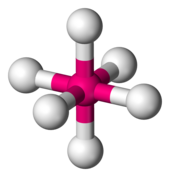|
Double groupThe concept of a double group was introduced by Hans Bethe for the quantitative treatment of magnetochemistry. Because the fermions' phase changes with 360-degree rotation, enhanced symmetry groups that describe band degeneracy and topological properties of magnonic systems are needed, which depend not only on geometric rotation, but on the corresponding fermionic phase factor in representations (for the related mathematical concept, see the formal definition). They were introduced for studying complexes of ions that have a single unpaired electron in the metal ion's valence electron shell, like Ti3+, and complexes of ions that have a single "vacancy" in the valence shell, like Cu2+.[1][2] In the specific instances of complexes of metal ions that have the electronic configurations 3d1, 3d9, 4f1 and 4f13, rotation by 360° must be treated as a symmetry operation R, in a separate class from the identity operation E. This arises from the nature of the wave function for electron spin. A double group is formed by combining a molecular point group with the group {E, R} that has two symmetry operations, identity and rotation by 360°. The double group has twice the number of symmetry operations compared to the molecular point group. BackgroundIn magnetochemistry, the need for a double group arises in a very particular circumstance, namely, in the treatment of the paramagnetism of complexes of a metal ion in whose electronic structure there is a single electron (or its equivalent, a single vacancy) in a metal ion's d- or f-shell. This occurs, for example, with the elements copper and silver in the +2 oxidation state, where there is a single vacancy in a d electron shell, with titanium(III), which has a single electron in the 3d shell, and with cerium(III), which has a single electron in the 4f shell. In group theory, the character , for rotation of a molecular wavefunction for angular momentum by an angle α is given by where ; angular momentum is the vector sum of orbital and spin angular momentum. This formula applies with most paramagnetic chemical compounds of transition metals and lanthanides. However, in a complex containing an atom with a single electron in the valence shell, the character, , for a rotation through an angle of about an axis through that atom is equal to minus the character for a rotation through an angle of [3] The change of sign cannot be true for an identity operation in any point group. Therefore, a double group, in which rotation by , is classified as being distinct from the identity operation, is used. A character table for the double group D′4 is as follows. The new symmetry operations are shown in the second row of the table.
The symmetry operations such as C4 and C4R belong to the same class but the column header is shown, for convenience, in two rows, rather than C4, C4R in a single row. Character tables for the double groups T′, O′, Td′, D3h′, C6v′, D6′, D2d′, C4v′, D4′, C3v′, D3′, C2v′, D2′ and R(3)′ are given in Salthouse and Ware.[4] Applications   The need for a double group occurs, for example, in the treatment of magnetic properties of 6-coordinate complexes of copper(II). The electronic configuration of the central Cu2+ ion can be written as [Ar]3d9. It can be said that there is a single vacancy, or hole, in the copper 3d-electron shell, which can contain up to 10 electrons. The ion [Cu(H2O)6]2+ is a typical example of a compound with this characteristic.
With species such as the square-planar complex of the silver(II) ion [AgF4]2− the relevant double group is also D4′; deviations from the spin-only value are greater as the magnitude of spin–orbit coupling is greater for silver(II) than for copper(II).[5] A double group is also used for some compounds of titanium in the +3 oxidation state. Titanium(III) has a single electron in the 3d shell; the magnetic moments of its complexes have been found to lie in the range 1.63–1.81 B.M. at room temperature.[6] The double group O′ is used to classify their electronic states. The cerium(III) ion, Ce3+, has a single electron in the 4f shell. The magnetic properties of octahedral complexes of this ion are treated using the double group O′. When a cerium(III) ion is encapsulated in a C60 cage, the formula of the endohedral fullerene is written as {Ce3+@C603−}.[7] The magnetic properties of the compound are treated using the icosahedral double group I2h. [8] Free radicalsDouble groups may be used in connection with free radicals. This has been illustrated for the species CH3F+ and CH3BF2+, each of which contain a single unpaired electron.[9] See alsoReferences
Further reading
|







